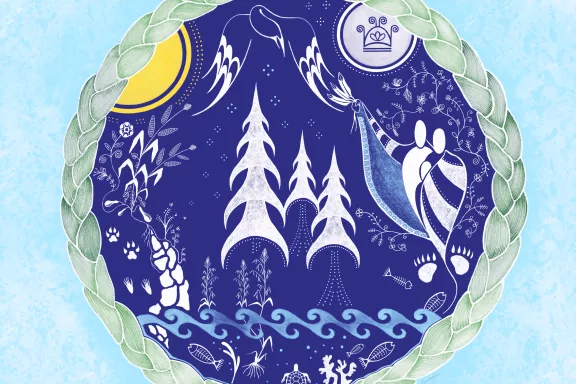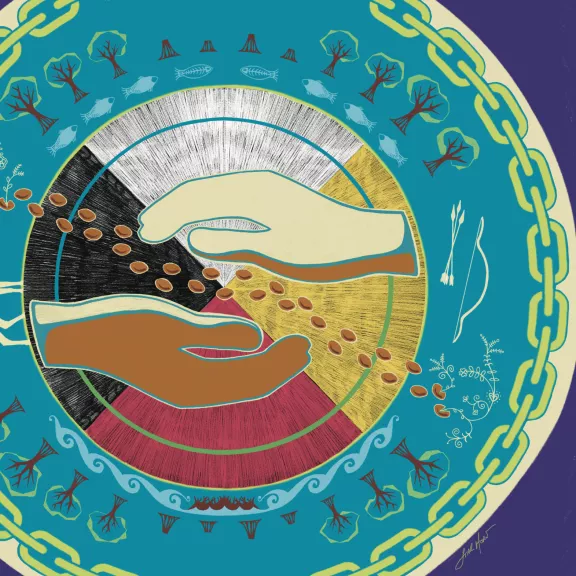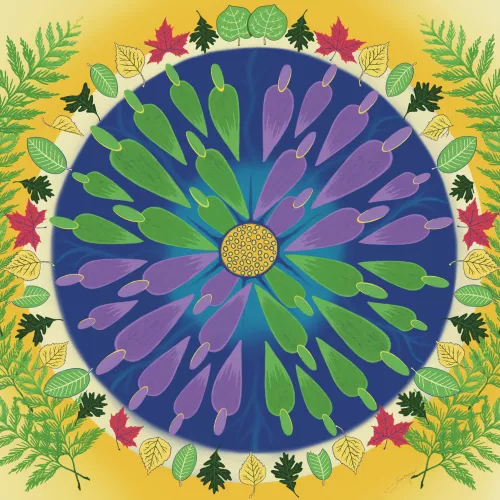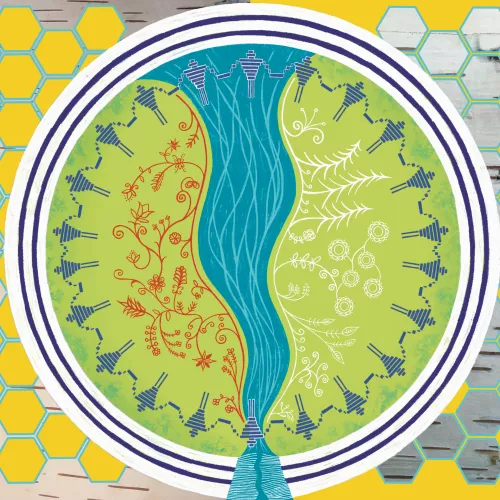

Written by Star Horn, Kanien'kehá:ka artist
Balance
Circularity has been a way of life for millennia for Indigenous peoples worldwide. The practice of crop rotation, sustainable hunting and gathering practices along with recycling has long been a part of our traditional way of life. A circular economy has never been a detached concept, but rather a complete way of life. The natural world, now commonly referred to as the “environment”, is not viewed as a separate entity but one, interconnected aspect of the whole.
The Medicine Wheel
The Medicine Wheel can be described in one word: balance. Medicine wheels represent the continuous interaction of the physical, emotional, mental, and spiritual realities. The circle shape represents the interconnectivity of all aspects of one’s being, including the connection with the natural world. We as humans must see ourselves as being connected and reliant on the natural world, not above it, nor in control of it.
Two hands exchanging seeds
The inspiration for this element of the piece comes from the Indigenous women of the Talamanca region in Costa Rica who started an association from which "traditional medicinal plants and local native seed varieties are grown and exchanged, creating local exchange fairs between families and communities, which help strengthen food sovereignty and security as well as community resilience in the face of external shocks. A system rooted in reciprocity and self-sufficiency.”1 In addition, the association also trains women in rotational and regenerative agroforestry. These concepts are universal for Indigenous people and should be considered more often. The seeds are shown growing roots, medicines, and food. In turn, these plants drop more seeds, and the cycle continues.
The chain
A circular chain reinforces the interconnectivity philosophy. Humans are part of this chain along with the animal world and natural world. A missing link in this chain weakens us all.
Trees alongside several harvested trees, and fish and some skeletons of fish
Both symbolize the thoughtful use of each. Enough taken for sustainability, but not depleted to cause imbalance in nature. The Seventh Generation Principle is based on an ancient Haudenosaunee (Iroquois) philosophy that the decisions we make today should result in a sustainable world seven generations into the future.
The water with a beaver dam
Positioned below the Medicine Wheel, the beaver dam depicts the importance the beaver has in natural ecosystems. The natural instinct of the beaver is to create a home by taking down trees and creating natural dams in waterways. Often misunderstood as a nuisance throughout history, environmentalists now understand how ponds increase stream flows in seasonally dry streams by storing run-off in the rainy season, which raises groundwater tables. Beaver dams have been shown to create habitat abundant with flora and grasses that create nesting areas for numerous types of birds. They have been shown to have a beneficial effect on trout and salmon populations as well. This is an example of the circularity of nature.
Recently, I read a story about the plight of the great Colorado River. Explaining how human interference has caused it to start drying up, the local expert used the term “serves” as in “this river serves some 4 million people”.
Natural elements are often defined in the English language as lesser elements to human ones, which reinforces a worldview that nature is somehow separate or even below humans. The river isn’t meant to 'serve us'. The Indigenous world view shows that we should be grateful enough to treat it with respect in order for it to sustain itself and our lives.
The caribou, bows and arrows
The caribou, bows and arrows represent the responsible hunting practices of Indigenous people. It is common practice to 'give thanks' to both the animal and the Creator when taking an animal's life. It is then our responsibility to use every part of the animal (food, clothing, tools) in order to keep the natural world sustainable.
Nia:wen (Thank you!)
sh
1 Sourced from https://www.youtube.com/watch?v=J8BCScMJOUw

